Fernando Caruncho
Fernando Caruncho (born September 6, 1957 in Madrid, Spain) is an International Landscape designer and philosopher. Famous for his minimalist gardens and the use of light and organic shapes.
Fernando Caruncho | |
|---|---|
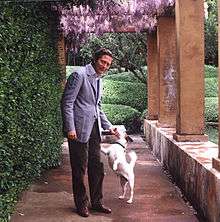 | |
| Born | 1957-09-06 Madrid, |
| Nationality | Spanish |
| Occupation | Landscape designer and philosopher |
| Years active | 1978 - Present |
| Website | http://fernandocaruncho.com |
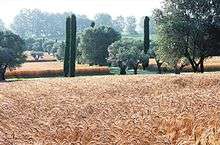
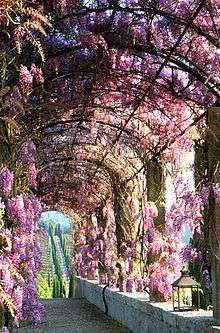
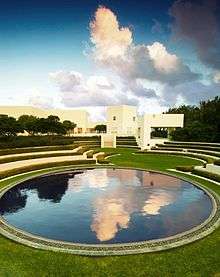
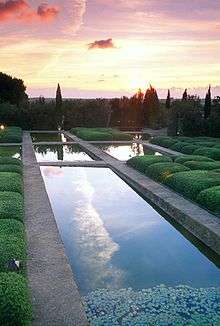
Life
As he has expressed on many occasions, he received education in the nature during his childhood and adolescence, which marked him deeply.[1]
At 1975, at the age of 18, Fernando Caruncho started his philosophy studies in the Universidad Autónoma of Madrid,[2] where he had the experience to learn about the philosophy of the early Greek philosophers who strongly marked him, as well as other thinkers of our day, heirs of this tradition up to the philosophers.[3] This is why he is very influenced by aspects related to geometry, light and the knowledge of nature.[4] During his career the influence of the world of poetry, music and painting is recognized, which have been essential to shape his eye and sensibility to read the site and translate it with a new contemporary language to the garden.[5]
In 1979 he began his studies at the Castillo de Batres, private landscaping school in Madrid, in these years he unites both influences giving his work as a gardener a personal identity and character.[6]
Career
In 1979 Caruncho established his own studio. His first work accomplished at the age of 21, in a house in Madrid, published in VOGUE DECORATION in May 1987, Edited in Paris.
His second major publication was in July 1992 in that same magazine after two issues in which special attention is devoted to Jacques Wirtz and Russell Page, written by Jean-Paul Pigeat, Director General of Jardines de France and founder of the Festival des Jardins Chaumont-sur-Loire. He was invited to the first edition along with the great 10 Landscape designers at that moment,[7] being Caruncho the youngest of all of them by far.
His career continues with a series of projects in Spain, country which rejoins the rich Spanish gardens tradition with great enthusiasm, gardens which essentially influenced him,[1] such as the Alhambra, Patio de los Naranjos, or the Alcazar in Seville.
It is after 15 years of intense experience performing gardens when he had the opportunity to make his first project in the United States, although previously he worked in France and Italy, and continues his long career in which he is immersed today: Cotswolds in England, Marrakech in Morocco, Oakland in New Zealand, Tokyo in Japan...[8]
His most recent projects are in Lugano, Switzerland; Isola Bella, a Project of an island in Maine, Fundación Botín working together with Renzo Piano in Santander, Spain; a Project next to the sea in Greece; and one at Vigneto de L’Amastuola in Apulia, Italy.[9]
About his work
In Caruncho´s work, light is the key element of the garden. In addition to the light, the geometry and the relation of the garden and landscape architecture. When he speaks about geometry he always insists that it may be obvious or hidden, but it is without a doubt the way to read or interpret the place, and in his gardens there is a clear example of this.
Nowadays in his studio architecture projects are developed with a new concept: The architecture forms a whole unity with the garden.
To reflect Caruncho´s world it is very interesting to go to the sources who have studied his work and belong to the world of gardening, history and art, such as Dan Kiley, master of American landscape design of the last 50 years, who wrote the preface to the book Mirrors of Paradise by Guy Cooper and Gordon Taylor, a book that collected the first 15 years of Fernando Caruncho´s work.
Dan Kiley recognises Fernando Caruncho as his successor,[10] as he bases on his same principles and design ideals. Dan Kiley highlights Fernando Caruncho´s relationship with religion as a search of the place man takes up in the world, Highlighting the landscape design should not be a mere reorganization of elements, it must capture the higher order that governs all things.
"My career is approaching its sunset, and in Caruncho I see someone who may well be the only landscape architect who is guided by the same principles and ideals that I have tried to realize over the course of my work. I have been hoping that my way of thinking, which is purely a method of recognizing and solving a problem and is not necessarily unique to me, would be projected, and I believe he is the ideal one to carry it forward."
"Caruncho’s relation to religion is important. It is easy to see his correspondence of religion and environment, like falling over into something it’s obvious once you have the knowledge and the background. What is religion but our desire to know where, how, and why we stand in this world? And as I said in my own book, "The greatest contribution a designer can make is to link the human and the natural in such a way as to recall our fundamental place in the scheme of things."
The design of the landscape should not be a superficial reordering of natural elements merely to delight the eye. There is a larger and greater order, and I feel confident that Fernando Caruncho is one man who is able to listen to his voice with his heart and translate it to the land with his mind."
Guy Cooper and Gordon Taylor affirm Fernando Caruncho makes the agriculture meet contemporary garden in the late 20th century, they highlight his classical education, as it shows his deep sensibility, and extraordinary sophistication, and they underline his handling of light and vision of the garden as a mirror of the universe.[11]
"Ancient agriculture meets formal contemporary garden design in the late twentieth century.
Caruncho is classically educated, as can be seen from any of his designs which combine profound simplicity with extraordinary sophistication.
Caruncho says that his designs are a constant attempt "to capture the light (vibration lumineuse) "in the garden space, through a formal setting of the simplest elements: "everything in a Spanish garden is founded in how you deal with the light"
"Caruncho sees the garden as a mirror of the universe: "I Strive to arrange a space that invites reflection and inquiry by allowing the light to delineate geometries, perspectives and symmetries "
Kirsty Fergusson remarks Fernando Caruncho´s philosophical bases as a trigger of his curiosity in the relation between man and nature, and its application to the world of garden. Expressing himself with the language of philosophy with a deep respect to theology.
Also, Kirsty Fergusson highlights the sources of inspiration of Fernando Caruncho as diverse as Zen, European Classicism, and his use of light, by which he makes intelligible geometry. She also highlights the universality of the language of his gardens.[12]
"Caruncho studied philosophy at the University of Madrid and his fascination with pre-Socratic Greek philosophy awakened a deep curiosity about the relationship between man and the natural world which translated itself into a preoccupation with garden design. The best gardens, he felt, acted as portals to a lost and innocent world where man understood his position in the universe, conversing on an intuitive an intimate level with the hidden mainspring of the world. Caruncho prefers to express himself in the language of philosophy, yet he is thinking is permeated by a profound respect for theology, believing the origins of the gardens making to have been formed within a religious context"
"While the overall impression is of minimalist modernism, inspiration from sources as diverse as Islam, Zen, and European classicism is clearly in evidence"
"His use of light is one of the most remarkable features of his work. Light, he believes, makes the languages of geometry intelligible."
"The universality of the language his gardens speak is evident in the growing demand for his work around the world."
Paul Jean Piaget highlights that, although most of Fernando Caruncho gardens are not open to the public, they will still leave a deep mark in the Mediterranean Garden scenery in the coming decades.[13]
"Il se considère comme un jardinier et non comme un architecte paysagiste, terme qu’il trouve prétentieux et superficiel. "
"Pour Chaumont, face à la sophistication des tours du château, il propose une gloriette de bois brut, construite à partir de troncs non écorcés récupérés des abattages d’arbres malades du parc. On peut difficilement faire moins cher et, finalement plus juste en tous points: la pente vers le château, l’équilibre des formes, la justesse des choix de végétaux. "
"La plupart des jardins de Fernando Caruncho ne sont pas ouverts à la visite, ce qui est finalement très bien: on a bien le temps de s’apercevoir qu’il laissera une trace sans équivalent dans la nouvelle création de jardins méditerranéens des prochaines décennies. "
Paul Jean Piaget remarks that Fernando Caruncho´s work will mark our time even working almost exclusively in the private sector.
"Aujourd’hui, Caruncho conçoit des jardins étonnants, où des sols de marbre géométriques côtoient un champ de blé, où une maison d’été se résout en une structure de plantes grimpantes. Mais qui est Caruncho, qui refuse de travailler pour la commande publique, mais dont les formes paysagères marquent notre époque? »
Jane Amidon highlights that despite being classic at first sight, Fernando Caruncho rearranges the elements of the garden to get an impression of modernity.[14]
"A classicist at first glance, landscape architect Fernando Caruncho takes traditional crops, harvest techniques and water-collection methods and rearranges then to find a modernist spatial sensibility. At Caruncho agricultural estate, pure planes and individual objects establish orientations that extend far beyond the given site and time."
Penelope Hobhouse remarks his special relationship between the history of the land and its agricultural tradition, implementing to his designs a basic grid system to be applied to the productive and decorative landscaping design that joins the individual elements providing a basic purity to the design through straight lines and right angles emphasizing light and shadows.
She also notes that Fernando Caruncho believes that the mind craves the peace that geometry grants it, being the antithesis to the English Jekyll Style Garden.[15]
"He seems inspired by a search for a particular relationship between the history of the land and its agricultural tradition. The implementation of his designs relies on a basic grid system that is applicable to both productive and decorative landscaping and unites all the individual elements"
"Caruncho brings a basic purity to design, using straight lines and right angles on a large landscape scale, emphasizing light and shadow, movement, form, leaf colour, and texture, with little reference to flowers."
"He believes that the mind craves the reassurance of geometry and his schemes are the antithesis of the popular romantic Jekyll-style English garden, in which plan saves disguise any formality in structure"
Penelope Hobhouse describes the book on Fernando Caruncho’s work, as one of her essentials.
"I have also learned a great deal from the books on modern gardens and their architects by Guy Cooper and Gordon Taylor. Quite a collection, they take up considerable space. My favourite is on the works of Fernando Caruncho, perhaps the best of our living practitioners.
Monty Don, in his series Around the World in 80 Gardens, highlighted his admiration for Fernando Caruncho´s work, and his blend of spirituality and philosophy, which he simply considers art, considering him one of the true geniuses of garden design, remarking the gardens can be completely modern, showing that without spirituality, gardens are simply a reorganization of plants.[16]
"I admired his work beyond measure. It seemed to combine a feeling for landscape, gardens, spirituality and philosophy that was immediately exciting and inspiring. He had that magic that transcended the merely attractive or interested. This was art."
"I liked Fernando Caruncho enormously and found we have a very similar outlook on garden design –we like to let the garden find itself, rather than impose a preconceived plan on to the land."
"He is intense, poetic, wistful, and modest, and there is something almost very old-fashioned and slightly innocent about him."
"Without doubt he is one of the true geniuses of garden design."
"Finally my visit to the great Fernando Caruncho was both inspiring because it reinforced the fact that gardens can be completely modern and also because it showed that without spirituality they become just an arrangement of plants. "
Nancy Hass, in her article for T Magazine of The New York Times, highlights the hypnotic curves of the Amastuola, which at first glance do not seem the distinctive features of the work of Fernando Caruncho, but the vineyard combines straight lines with an organic impulse.[17]
"At first glance, the hypnotic curves of Amastuola seem uncharacteristic of Caruncho. He is a master of the right angle, of near impossible planes and monochromatic environments…but the vineyard…combines an allegiance to straight lines with an organic impulse…visually you have the shock of the grid against the waves"
Tim Richardson points out that his formality mark is deep, it is not limited to being a design tool, it is more like a fundamental belief inspired through his philosophical studies. This sense of order and balance results from the combination of Fernando Caruncho’s aesthetic legacy, with the history of landscaping.[18]
"His particular brand of formality runs deep; it is not a simple design tool but a fundamental belief, inspired by his philosophical studies notably of the ancient Greeks. The sense of order and balance, of permanence and history is archived by bringing together by Caruncho own aesthetic heritage and the history of the landscape. He is particularly interested in the science of irrigation and ancient agricultural patterns. "

Projects
Among the more than 150 projects, some of the most significant projects are:[9]
- Mas de les Voltes, Ampurdán, Spain[19]
- Casa Caruncho, Madrid, Spain
- Mas Floris, Ampurdán, Spain
- Flynn, Boca Ratón, Florida, USA
- Mavec-Nordberg, New Jersey, USA
- Isola Bella, Maine, USA
- Hauraki Gulf Garden, the North Island of New Zealand
- Embassy of Spain, Tokyo, Japan
- Garden of the Seven Mountains, Lugano, Switzerland
- Casa del Agua, Greece
- Jardines de Pereda, Fundación Botín, Santander, Spain.[20][21]
Honours
Notes and references
Notes
- Ybarra, Txema (August 23, 2013). "Although their referents remain in Spain. He learned to love the countryside and nature in the home of relatives in Ronda (Málaga), during the long summer months; The Alhambra is a constant source of inspiration for "combining architecture and landscape as it has done it again"; and it was formed in Madrid, in the school of Castillo de Batres, which gives great flexibility, as the plateau "is a litmus test. It is hard, violent. Stop you any frills. As other climates do not scared. in return, offers an intense light with which to play. And a garden is light or rather light reverb "he says". Expansion. Retrieved August 23, 2013.
- Carro, Fernando (April 1, 2011). "Fernando Caruncho is one of the most internationally renowned Spanish landscape. He started the career of Arts in 1975 at the Autonomous University of Madrid. In 1978 he began his studies in the gardening and landscaping Castillo de Batres School, creating his own studio in 1979 and has since completed over 200 projects. Making your activity in Spain, United States, Japan, Daughter Zealand, Italy, France, England, Greece and other countries. Philosopher and gardener, has based the concept of his creations, his sensitivity, his knowledge of Greek and Roman philosophers and the historical background of the Spanish Garden. The design of the gardens is based on structural frames, using geometry, as director element". Verdeden. Retrieved April 1, 2011.
- Aguilar Rivera, José Antonio (June 1, 2011). "The renowned Spanish designer Fernando Caruncho explains how his philosophy studies took him to the garden and discover what he calls the "spirit Geometer". * A point of succumbing to pessimism "cold ruin of our times" and abandon their studies philosophy, Caruncho discovered ancient Greece and particularly Euripides. Among the ancient philosophy often taught or talked in gardens: those of academe and the Lyceum. In these walled gardens, students learned to listen to Plato and Aristotle. That discovery transformed Caruncho young philosopher in ancient gardener. Pythagoras found a riddle ("everything is number") and in Plato an enigmatic warning issued from the entrance of the academy, "those who are not familiar with geometry not come."". Nexos. Retrieved June 1, 2011.
- Alas, Amelia (April 27, 2014). "His reference landscape: The coruñés Fernando Caruncho, which uses geometry as a universal language. He has worked all over the world. One of his last works, La Terraza de los Laureles, is one of the top visits the Royal Botanic Gardens, Madrid". El Periódico de Cataluña. Retrieved April 1, 2011.
- Kingsbury, Noel, ed. (2005). Fernando Caruncho, "The spirit of the geometrician". London, UK: Vista. pp. 111–117.
- Simón Ruíz, Alfonso (June 26, 2014). "His answers involve philosophy and art. He not in vain began studying philosophy, a career he abandoned in the third grade when a person spoke studies gardener. "I realized that in the ancient world, the garden was very important," he says. "It was a way of doing philosophy". It was formed in Batres Castle, the only school, created by architect Luis Moreno de Cala. His first opportunity he gave a family, and that work was featured in a design magazine."I'm a gardener, not a landscaper" he explains when talking about his profession. "From a young age I say I'm a gardener, because it is a word that carries a memory of 5000 years, nuanced, I do not want to miss. Not only gardener scissors, is the man who wants to live in the garden for another way to access knowledge. " It notes that the keys to practice good pass to wait, observe and eventually translate into space". Cinco Días. Retrieved June 26, 2014.
- Imaz, Belén. "Fernando Caruncho, Jim Denevan, James Corner, Helen Dillon, Mary Reynolds, Martha Schwartz, Vladimir Kitta, Patrick Blanc, Piet Oudolf, Petra Blasse". Revista AD.
- Nobel, Philip (April 30, 2005). "Refining the Box". Architectural Digest. Retrieved April 30, 2005.
- "Fernando Caruncho".
- Kiley, Dan (December 2000). Mirrors of Paradise, The Gardens of Fernando Caruncho. Monaccelli Press. ISBN 978-1580930710.
- Cooper, Guy; Taylor, Gordon (March 2000). Gardens for the Future, Gestures Against the Wild. Conran Octopus Ltd. ISBN 978-1840910872.
- Fergusson, Kirsty (March 2009). The Oxford Companion to the Garden. Editorial Oxford University Press. ISBN 978-0199551972.
- Pigeat, Jean-Paul (April 2002). Jardins de la Méditerranée. Plume. ISBN 978-2-84110-162-7.
- Amidon, Jane (July 2003). Radical Landscapes. Thames & Hudson. ISBN 978-0500284278.
- Hobhouse, Penelope (September 2004). The Story of the Gardening. Dorling Kindersley Limited. ISBN 978-1405307147.
- Don, Monty (October 2008). Around the World in 80 gardens. Weidenfeld & Nicolson. ISBN 978-0753823187.
- Hass, Nancy (July 7, 2015). "Fernando Caruncho's Shock Waves". New York Times. Retrieved July 7, 2015.
- Richardson, Tim (January 2000). The Garden Book. Phaidon. ISBN 978-0714839851.
- Recio, Miguel (August 20, 2012). "Mas de les Voltes". Arañazos en el cielo. Retrieved August 20, 2012.
- Botín, Fundación (July 22, 2014). "El Centro Botín inicia su actividad con la inauguración de los Jardines de Pereda y del túnel que conecta el centro de Santander con la Bahía". Fundación Botín. Retrieved July 22, 2014.
- Bermúdez, Pablo (July 22, 2014). "Inauguración de los Jardines de Pereda". El diario montañés. Retrieved July 22, 2014.
- "ACCADEMICI D'ONORE". Archived from the original on 2016-03-04. Retrieved 2016-02-08.
- "STUDI, FONTI E INTERPRETAZIONI DI 450 ANNI DI STORIA" (PDF). Archived from the original (PDF) on 2016-03-03. Retrieved 2016-02-15.
References
- Kingsbury, Noel, ed. (2005). Fernando Caruncho, "The spirit of the geometrician". London, UK: Vista. pp. 111–117.
- Kiley, Dan (December 2000). Mirrors of Paradise, The Gardens of Fernando Caruncho. Monaccelli Press. ISBN 978-1580930710.
- Cooper, Guy; Taylor, Gordon (March 2000). Gardens for the Future, Gestures Against the Wild. Conran Octopus Ltd. ISBN 978-1840910872.
- Fergusson, Kirsty (March 2009). The Oxford Companion to the Garden. Editorial Oxford University Press. ISBN 978-0199551972.
- Pigeat, Jean-Paul (April 2002). Jardins de la Méditerranée. Plume. ISBN 978-2-84110-162-7.
- Amidon, Jane (July 2003). Radical Landscapes. Thames & Hudson. ISBN 978-0500284278.
- Hobhouse, Penelope (September 2004). The Story of the Gardening. Dorling Kindersley Limited. ISBN 978-1405307147.
- Don, Monty (October 2008). Around the World in 80 gardens. Weidenfeld & Nicolson. ISBN 978-0753823187.
- Richardson, Tim (January 2000). The Garden Book. Phaidon. ISBN 978-0714839851.